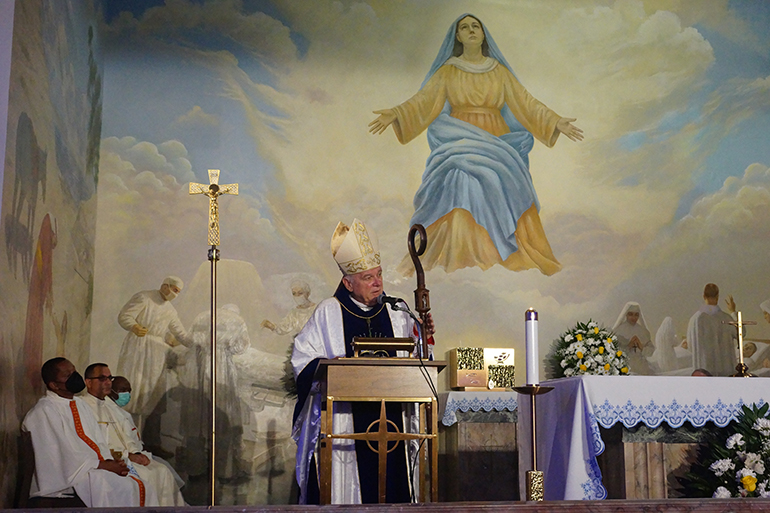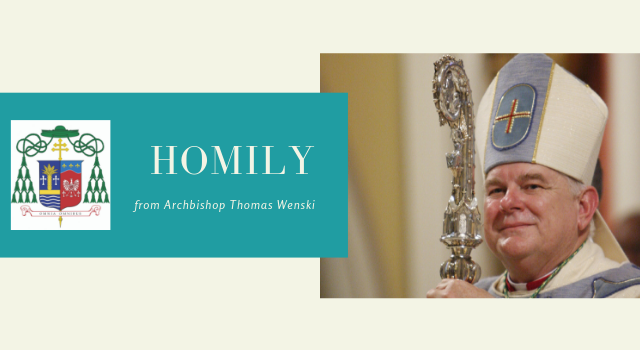By Archbishop Thomas Wenski - The Archdiocese of Miami

Photographer: COURTESY | Sr. Elizabeth Worley
Archbishop Thomas Wenski preaches the homily during a Mass in the chapel of Mercy Hospital, Miami, on the feast of Our Lady of Mercy, and alsothe vigil of the 26th Sunday in Ordinary Time, Sept. 24, 2022.
Archbishop Thomas Wenski preached this homily during a Mass at Mercy Hospital, Miami, on the feast of Our Lady of Mercy, and the vigil of the 26th Sunday in Ordinary Time, Sept. 24, 2022.
During this Vigil of Sunday, we also commemorate a feast of Mary: Mary, the Mother of Mercy. And so, this evening we involve Mary asking her to intercede for those who seek comfort and healing at this hospital – and for the doctors, nurses and health care professionals who care for them.
As the mother of the Son of God, Mary participated in and revealed the mercy of God by sharing most intimately in her Son’s redeeming mission. And so she experienced pain and suffering in her earthly life as the Mother of Sorrows, as Simeon had prophesied at the Presentation of the Lord in the temple. As the Sorrowful Mother who stood at the cross of her suffering son, Mary still stands by the members of her Son’s Body who in their own suffering bear the signs of his passion.
María experimentó dolor y sufrimiento en su vida terrenal como la Madre Dolorosa. Así como la Madre Dolorosa se paró frente a la cruz de su hijo agonizante, María aún se coloca al lado de los miembros del Cuerpo de su Hijo quienes en su propio sufrimiento llevan las marcas de su pasión.
It has always been hard for us to accept the mystery of pain and human suffering especially when this mystery touches the young and innocent. Why does a loving and just God permit us to suffer? This question is as old as time itself. Yet, like the Old Testament Job, we still demand answers, we want reasons. But as with Job so too with us, God is not forthcoming with pat answers – at least, not on this side of heaven. God’s response is just one word: Jesus.
Of course, Jesus did not come to explain away suffering; he came to take it upon himself. His solidarity with the world of pain transforms it – for “pain received with faith becomes the door by which to enter the mystery of the redemptive suffering of Jesus and to reach with him the peace and the happiness of his Resurrection.”
In other words, if the Lord takes us to it, he’ll help us through it. In Christ, our suffering acquires a new meaning; in Christ, our suffering attains new power – and a mysterious fruitfulness. United to Christ, the one who suffers with hope and with meek self-abandonment to the will of God, becomes a living offering for the salvation of the world. Offering up our own pains and sufferings becomes an eloquent and a powerful prayer.
As a Haitian proverb says so well: Ou peye doktè a, men se Bondye ki geri (You pay the doctor, but God heals). And so, over the centuries, people of faith have found in times of sickness and trial strength in prayer. And many – through Mary’s intercession – have experienced healing.
But even when prayers were not answered by a physical cure, people of faith have been helped by the Mother of Mercy to find peace in their acceptance of God’s will. Mary, of course, is the model of that self-abandonment to the will of God. And therefore, it is no wonder why the sick seek out her powerful protection and intercession. We ask her to teach us to say “yes” as she did – for that “yes” joined her to the redeeming mission of Christ. We need her to take us by the hand and lead us to pronounce our own “yes” to the will of God, with all our “existence interwoven with joys and sadness, hopes and disappointments, in the awareness that tribulations, pain and suffering make rich the meaning of our pilgrimage on the earth.”
As Mary renewed her “yes,” given at the Annunciation, at the foot of the Cross, we too must renew the “yes” of our baptism by accepting the daily crosses we may be asked to carry.
María es, por supuesto, el modelo de ese total abandono a la voluntad de Dios. Y por lo tanto, no es extraño por qué los enfermos buscan su poderosa protección e intercesión. Necesitamos que ella nos lleve de la mano y nos guíe a pronunciar nuestro propio “si” a la voluntad de Dios, con toda nuestra “existencia entrelazada con las alegrías y penas, esperanzas y desilusiones, aceptando que las tribulaciones, dolores y sufrimientos hacen rico el sentido de peregrinos en la tierra”.
To the Mother of Mercy, we commend the sick of our communities so that they will never feel that they are abandoned or disvalued because of their illness and frailty. We also entrust to her the family members of the sick and all health care professionals so that they, in their care of the sick, may reflect Mary’s own tender and maternal care towards the suffering members of the Body of Christ.
As Christians we must strive to recognize in the features of every suffering person the face of Christ himself. Too often, the sick complain of being depersonalized by the experience of their illness. And it’s no wonder – in a highly technological and bureaucratic world, it can seem that by becoming ill they lose their identity, their personhood. They can easily be reduced to “the lung case” in Room 1080-B; or the “Medicaid" case in cubicle D.
The mission of this hospital, and the mission of the Church in her pastoral care for the sick and their families, is to embrace the sick person as a whole person.
A Nuestra Señora de la Merced, le encomendamos los enfermos de nuestras comunidades para que nunca se sientan abandonados y desvalidos debido a sus enfermedades o fragilidades. También le encomendamos a ella los familiares de los enfermos y todos aquellos profesionales de la salud para que en su cuido del enfermo puedan reflejar el tierno y maternal cuidado de María hacia los miembros del Cuerpo de Cristo que sufren.
And so, to those who are injured or sick, we say: Courage, God has not forgotten you. Christ suffers with you. And by offering up your sufferings, you can collaborate with him in the redemption of the world.
O Mary, Immaculate Virgin, woman of suffering and hope, be kind to every suffering person, obtain fullness of life for each one.

